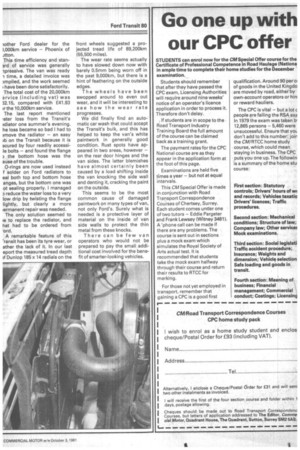Roses most of the wal
Page 14

Page 15

If you've noticed an error in this article please click here to report it so we can fix it.
OMMERCIAL MOTOR'S test ransit has now completed 3,253km (16,329 miles) and )ntinues to impress with its reability and versatility.
Everyone who has driven it, 'eluding a number of "carily" drivers, has found no diffiJIty in adapting to it and there !ally have been no serious iticisms, just some niggles.
It certainly would be interestg to discover just how many :cidents have been caused in ixed fleets by drivers climbing to a strange van and fumbling ound for some difficult-to-find intro Is It is impossible to know just )1.4/ much the instantly likeable Jality of the van has contriited to the marque's outstandg success in this country, but it ust be a major factor.
An easily quantifiable figure, wever, is the van's fuel conmption. Our test vehicle is the ansit 80 fitted with Ford's 1.6re ohc engine developing kW (64bhp) DIN at 4,750rpm. On our original test in January s year over CM's light van test ute, fuel return for the fullyden Transit was 12.47 li1/100km (22.65mpg) improving 10.73 litre/100km (26.3mpg) when the van was unladen. The overall average fuel consumption of the Transit to date confirms the validity of these results.
In 25,610km (15,928 miles) the Transit has used 643.36 gallons of two-star (91 octane) petrol — an average of 11.41 litre/100km (24.76mpg). That includes all kinds of operating conditions, such as London traffic, highspeed motorway work, and a variety of loading conditions from fully laden to part laden to empty.
It is interesting that the fuel cost in pence per mile at that mpg figure and assuming a slightly out of date cost per gallon of £1.50 works out to 6.06 pence a mile — almost identical to the 6p a mile figure in Commercial Motor's Tables of Operating Costs for this type of vehicle.
After the near-disastrous mishap soon after the 10,000km (6,000 mile) service completed by Dees of Croydon (a loose sump plug was spotted just in time), not surprisingly we tried lother Ford dealer for the ),000km service — Phoenix of Mon.
This time efficiency and stan3rd of service was generally pressive. The van was ready 1 time, a detailed invoice was )mpiled, and the work seemed I have been done satisfactorily. The total cost of the 20,000km arvice (including vat) was 32.15, compared with £41.93 )r: the 10,000km service.
The last report mentioned ,ater loss from the Transit's idiator one summer's evening. he loss became so bad I had to :move the radiator — an easy )b on the Transit because it is acured by four readily accessile bolts — and found the flange ) the bottom hose was the ause of the trouble.
0-rings are now used instead f solder on Ford radiators to eel both top and bottom hose anges, but the bottom one was ot sealing properly. I managed 3 reduce the water loss to a very low drip by twisting the flange lightly, but clearly a more lermanent repair was needed. The only solution seemed to le to replace the radiator, and hat had to be ordered from 'o rd.
A remarkable feature of this -ransit has been its tyre wear, or ather the lack of it. In our last eport the measured tread depth )f Dunlop 185 x 14 radials on the
front wheels suggested a projected tread life of 89,200km (55,500 miles).
The wear rate seems actually to have slowed down now with barely 0.5mm being worn off in the past 9,000km, but there is a hint of feathering on the outside edges.
The wheels have been swopped around to even out wear, and it will be interesting to see how the wear rate progresses.
We did finally find an automatic car wash that could accept the Transit's bulk, and this has helped to keep the van's white paintwork in generally good condition. Rust spots have appeared in two areas, however — on the rear door hinges and the van sides. The latter blemishes have almost certainly been caused by a load shifting inside the van knocking the side wall and denting it, cracking the paint on the outside.
This seems to be the most common cause of damaged paintwork on many types of van, not only Ford's. Surely what is needed is a protective layer of material on the inside of van side walls to protect the thin metal from these knocks.
There can be few van operators who would not be prepared to pay the small additional cost involved for the benefit of smarter-looking vehicles.
















































